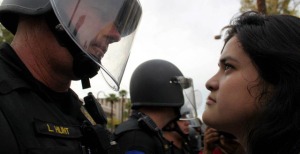On Valentine’s Day
2014, the Border Studies group embarked to a migrant trail near Arivaca AZ, a
small border town about 60 miles south of Tucson. In order to arrive there, we
were required to drive through a border checkpoint, although the border patrol
agents let us pass through with little harassment or difficulty (this
definitely is not the case for all travelers). As we drove through the rolling
desert hills, I had little anticipation for the emotional scope of the day
ahead of me and I calmly viewed the beauty of the wild desert landscape, dotted
with cacti and shrubbery. After arriving into the town of Arivaca, we were joined by
Paula and John, two seasoned volunteers with No More Deaths, a desert
humanitarian camp that participates in water drops along migrant trails on the
border. Both also live and work in Casa Mariposa, a migrant hospitality house
in Tucson.
From there we began the 1.5-mile
hike through the land, largely overseen by AZ Game & Fish Department, and stopped at a small clearing along the
way to give some introductions and prepare for the experience ahead. John told
us to “think with our hearts, not our heads” in order to perceive the day ahead
with compassion as well as to eradicate the conceptual borders that exist
between our ears. Thus, we diverged from the canyon trail by passing through a
barbed wire cattle fence, and began to enter a migrant route. Immediately, I
noticed signs of life that were absent from the first half of our walk—a
flannel shirt hung on a branch, shoes left to decay in the dirt, and empty
water jugs. I thought about how each of these remnants carries a story, how
each represents the footprints of a person in the midst of the treacherous journey
north. As I imagined myriad histories and fates of the individuals who carried
each item, I was simultaneously struck by the impossibility of knowing—it was
as though I was communicating with ghosts.
I carried this emotional space with
me as I continued walking, constantly imagining myself stumbling over this
rocky terrain in the unforgiving darkness, branches hitting my face, tripping
and falling, getting lost, listening to the ominous drone of military planes
overhead… However, at the same time, in the midday sunshine of the warm desert
spring, this was merely a leisurely hike for our group. The natural beauty of
the canyon and the splendor of the mountains surrounding us betrayed a false
sense of peace. I considered how I can access these spaces with so much ease
and comfort, while for countless others, the fear of death and danger looms
around every corner. The opposition was jarring.
Within about 20 minutes, after
climbing over several large boulders, we arrived at a migrant shrine in a small
clearing. The shrine was essentially an alcove in a large rock wall, and was
filled with rosaries, candles, prayer cards, and photographs. Compared to the
ghosts of fear and uncertainty that seemed to haunt the rest of the trail and
amidst the hostility of the terrain, the shrine gave me a beautiful sense of
hopeful energy. Under the shrine, the canyon wall was lined with water jugs
left by humanitarian organizations, each bearing hopeful and heartening messages
written by volunteers. I learned later that in addition to providing encouragement
to migrants passing through, the purpose of these messages was to affirm that
the water was not a trap. Indeed, in an increasingly militarized borderlands
and such a hostile and xenophobic country, it would be difficult to know who
and what to trust.
From there we headed back to the town of Arivaca and stopped at volunteer-run organization called People Helping People in the Border Zone that focuses on educating the community about humanitarian aid and eliminating the border checkpoint in Arivaca. Although the town of Arivaca is largely white and the population has mixed opinions about immigration issues, the opposition to the checkpoint is broadly based because of concerns of militarization and harassment in the community. In addition to the negative ways that the checkpoint affects the Arizona citizens, it is a direct causation of migrant deaths in the area, because it forces people to travel farther in the wilderness to avoid the checkpoint, which takes over the only road in the community. Therefore, the organization sees the elimination of the checkpoint as a tangible goal that also makes a direct impact on the well being of people crossing through the area.
After previously having only a very faint, abstract concept of what crossing through the desert is like, the trip to the Arivaca borderlands was emotionally powerful. The experience forced me to position myself as a white, English-speaking, documented person in this migrant trail. Simultaneously, taking John’s advice to be guided by my heart, I imagined the hundreds who have traversed the same path with a dramatically different set of thoughts and feelings. Although my conception of crossing the border as an undocumented person is still hopelessly abstract, I still feel the ghosts of all of those who have walked there before and after me.
-- contributed by Nikki Johnson

